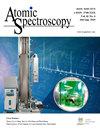Radiocarbon Sample Preparation Based On The Flam-Sealed Zn/Fe Reduction Method In Accelerator Mass Spectrometry Analysis
IF 2.3
2区 化学
Q1 SPECTROSCOPY
引用次数: 0
Abstract
: An alternative radiocarbon sample preparation with the flame-sealed Zn/Fe reduction method by removing the reagent of TiH 2 was developed, and the specifications and practices are described in detail. The graphitization parameters were optimized with 5 mg Fe powder (-325 mesh; H 2 -reduced spherical particles) as the catalyst, 15 mg Zn dust as the sole reductant and a reduction temperature of 500 °C for 3 h, followed by 550 °C for 4 h. The μm-scale morphology indicated that the spherical Fe particles were coated with a mix of graphite sheets and fuzz carbon. Simultaneously, SEM–EDS, XRD and XPS verified that the graphite-Fe target consisted of mostly graphitizable semidisordered carbon and Zn-Fe crystals, with minimal amounts of ZnO and Fe 3 ZnC crystals, which jointly ensured good performance (high and stable ion current output and good thermal conductivity) during the AMS measurements. The average fraction modern values of the SRM OX-II (consensus value, Fm=1.3407 ± 0.0019) and SRM IAEA-C7 (consensus value, Fm=0.4953 ± 0.0012) samples prepared from 2017 to present were 1.3403 ± 0.0058 (n=73) and 0.4964 ± 0.0031 (n=18), respectively. Thus, the long-term precision of the Zn/Fe sealed tube method was better than 6‰ and good accuracy was achieved over several years. The average background 14 C age of inorganic material was 43392 ± 1489 yr BP (n=44), and the ages of two 14 C-free organic materials were 45285 ± 2016 yr BP (n=15) and 46388 ± 2306 yr BP (n=36), indicating that low and stable carbon contamination levels were maintained throughout the entire chemical preparation process and AMS measurement over the last couple of years. The consistency between measured values and preferential values makes us confident in the preparation of various types of natural samples at normal mass size with our established vacuum line using the flame-sealed Zn/Fe reduction method.加速器质谱分析中基于火焰密封Zn/Fe还原法的放射性碳样品制备
:开发了一种用火焰密封Zn/Fe还原法去除TiH2试剂制备放射性碳样品的替代方法,并详细描述了其规范和实践。石墨化参数以5mg Fe粉末(-325目;H2还原的球形颗粒)为催化剂,15mg Zn粉为唯一还原剂,还原温度为500℃,持续3h,然后为550℃,持续4h。同时,SEM–EDS、XRD和XPS验证了石墨Fe靶主要由可石墨化的半等序碳和Zn-Fe晶体组成,其中ZnO和Fe3-ZnC晶体含量最低,这共同确保了AMS测量过程中的良好性能(高稳定的离子电流输出和良好的热导率)。2017年至今制备的SRM OX-II(一致值,Fm=1.3407±0.0019)和SRM IAEA-C7(一致值:Fm=0.4953±0.0012)样品的平均现代分数分别为1.3403±0.0058(n=73)和0.4964±0.0031(n=18)。因此,Zn/Fe密封管法的长期精度优于6‰,并在几年内取得了良好的精度。无机材料的平均背景14C年龄为43392±1489年BP(n=44),两种不含14C的有机材料的年龄分别为45285±2016年BP(n=15)和46388±2306年BP(n=36),表明在过去几年的整个化学制备过程和AMS测量中,碳污染水平保持在较低且稳定的水平。测量值和优先值之间的一致性使我们有信心使用火焰密封的Zn/Fe还原方法,用我们建立的真空管线制备正常质量尺寸的各种类型的天然样品。
本文章由计算机程序翻译,如有差异,请以英文原文为准。
求助全文
约1分钟内获得全文
求助全文
来源期刊

Atomic Spectroscopy
物理-光谱学
CiteScore
5.30
自引率
14.70%
发文量
42
审稿时长
4.5 months
期刊介绍:
The ATOMIC SPECTROSCOPY is a peer-reviewed international journal started in 1962 by Dr. Walter Slavin and now is published by Atomic Spectroscopy Press Limited (ASPL). It is intended for the rapid publication of both original articles and review articles in the fields of AAS, AFS, ICP-OES, ICP-MS, GD-MS, TIMS, SIMS, AMS, LIBS, XRF and related techniques. Manuscripts dealing with (i) instrumentation & fundamentals, (ii) methodology development & applications, and (iii) standard reference materials (SRMs) development can be submitted for publication.
 求助内容:
求助内容: 应助结果提醒方式:
应助结果提醒方式:


